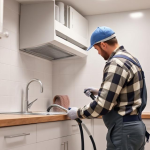With a commercial kitchen, cleanliness is a matter of good habit and legal and safety necessity. Perhaps most neglected, however, is the kitchen extraction system. If you're wondering, don't worry, many kitchen operators realize it's a must-have, but few are aware of the extent to which this service encompasses. This guide dissects just what's included in a standard kitchen extract cleaning , keeping you compliant, safe, and efficient.
 .
.
Why Kitchen Extract Cleaning Matters
Before diving into the specifics, it's important to understand what's included in a standard kitchen extract cleaning service and why it matters. Over time, grease, oil, and airborne contaminants build up inside your ductwork, hoods, fans, and filters. This buildup poses a significant fire hazard, affects air quality, and reduces system efficiency. Regular cleaning ensures your kitchen operates safely, complies with regulations, and maintains a clean, professional environment.
1. Canopy and Hood Degreasing
One of the initial items treated is the canopy or hood. This is the most exposed piece above the cooking surface and tends to be the filthiest. The inside and outside surfaces are thoroughly degreased by technicians, stripping away stubborn grease and grime. If you're wondering what a standard kitchen extract cleaning job entails, this is a significant portion. A clean canopy keeps grease from getting onto food and ensures good airflow.
2. Filter Debris Removal and Cleaning
Baffle filters or mesh filters within the canopy are taken out and cleaned with specialized degreasers or soak tanks. In other situations, very clogged filters need to be replaced. Filter cleaning is necessary since unclean filters limit airflow, raise energy consumption, and permit higher grease penetration to the ductwork.
3. Ductwork Inspection and Cleaning
This is the most critical part of the job. The ductwork, most of which is hidden behind walls or ceilings, traps the most grease. Mechanical brushes, scrapers, and vacuum machines are utilized by professionals to clean the accumulated residue. If you're inquiring about what's covered in an average kitchen extract clean, this step is essential in minimizing fire hazards and maintaining your system at optimal performance.
4. Extract Fan Cleaning
The extract fan pulls greasy air through the system. If not cleaned, it may overheat or break down because of excessive buildup. A normal cleaning covers a full inspection and degreasing of fan blades and motor casings. Correct fan maintenance enhances ventilation, minimizes noise, and prolongs the life of your equipment.
5. Installation of Access Panels (If Necessary)
In some instances, not all parts of the ductwork are accessible. Under such circumstances, technicians can suggest installing access panels. Although not always done under routine cleaning, it is usually included in service when total system accessibility is needed for compliance. Knowing what's in a typical kitchen extract cleaning service enables you to expect these recommendations and prepare accordingly.
6. Before-and-After Reports & Certificates
You should then be presented with a comprehensive hygiene report of the work undertaken, usually in the form of before and after photographs. A certificate of cleanliness is also provided, which is necessary for insurance and health inspections. This last step offers reassurance and proof of regulatory compliance.
 .
.Why Kitchen Extract Cleaning Matters
Before diving into the specifics, it's important to understand what's included in a standard kitchen extract cleaning service and why it matters. Over time, grease, oil, and airborne contaminants build up inside your ductwork, hoods, fans, and filters. This buildup poses a significant fire hazard, affects air quality, and reduces system efficiency. Regular cleaning ensures your kitchen operates safely, complies with regulations, and maintains a clean, professional environment.
1. Canopy and Hood Degreasing
One of the initial items treated is the canopy or hood. This is the most exposed piece above the cooking surface and tends to be the filthiest. The inside and outside surfaces are thoroughly degreased by technicians, stripping away stubborn grease and grime. If you're wondering what a standard kitchen extract cleaning job entails, this is a significant portion. A clean canopy keeps grease from getting onto food and ensures good airflow.
2. Filter Debris Removal and Cleaning
Baffle filters or mesh filters within the canopy are taken out and cleaned with specialized degreasers or soak tanks. In other situations, very clogged filters need to be replaced. Filter cleaning is necessary since unclean filters limit airflow, raise energy consumption, and permit higher grease penetration to the ductwork.
3. Ductwork Inspection and Cleaning
This is the most critical part of the job. The ductwork, most of which is hidden behind walls or ceilings, traps the most grease. Mechanical brushes, scrapers, and vacuum machines are utilized by professionals to clean the accumulated residue. If you're inquiring about what's covered in an average kitchen extract clean, this step is essential in minimizing fire hazards and maintaining your system at optimal performance.
4. Extract Fan Cleaning
The extract fan pulls greasy air through the system. If not cleaned, it may overheat or break down because of excessive buildup. A normal cleaning covers a full inspection and degreasing of fan blades and motor casings. Correct fan maintenance enhances ventilation, minimizes noise, and prolongs the life of your equipment.
5. Installation of Access Panels (If Necessary)
In some instances, not all parts of the ductwork are accessible. Under such circumstances, technicians can suggest installing access panels. Although not always done under routine cleaning, it is usually included in service when total system accessibility is needed for compliance. Knowing what's in a typical kitchen extract cleaning service enables you to expect these recommendations and prepare accordingly.
6. Before-and-After Reports & Certificates
You should then be presented with a comprehensive hygiene report of the work undertaken, usually in the form of before and after photographs. A certificate of cleanliness is also provided, which is necessary for insurance and health inspections. This last step offers reassurance and proof of regulatory compliance.
